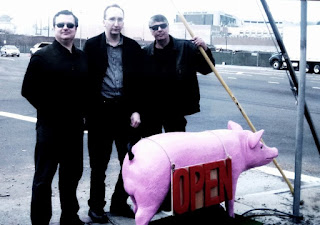Ramleh
RAMLEH are a British Power Electronics and Noise Rock group. Their single minded determination to push the boundaries of what can be achieved in music has seen them hailed as one of the most influential and groundbreaking underground groups of the last 25 years.
Originally formed in 1982 by Gary Mundy, RAMLEH were the flagship band for Mundy’s legendary BROKEN FLAG label. Between 1982 and 1984 RAMLEH recorded some of the earliest and heaviest examples of Power Electronics, with many releases and live performances, including the classic “A Return to Slavery” album.
Subsequent releases marked the development of a new sound, fusing psychedelic guitars with electronic noise. Between 1987 and 1989 RAMLEH became co-joined with Skullflower (then in the early stages of formation) with both bands sharing members and recording facilities.
In 1989 RAMLEH produced the album “Grudge for Life”, with the line-up of Gary Mundy and Philip Best (Whitehouse) and featuring a guitar-driven sound but with no percussion. Throughout the 1990’s, in a line up augmented with Anthony di Franco (Skullflower, AX, JFK) and Stuart Dennison (Skullflower), RAMLEH pushed further into the realms of Noise Rock producing albums such as “Homeless”, “Be Careful What You Wish For” and “Boeing”. In 1998 the group went on a long-term sabbatical.
In 2003 the group reconvened in a recording studio in London and have continued with the line-up of: Gary Mundy (Guitar, Electronics, Vocals), Anthony Di Franco (Bass Guitar, Synthesizers, Vocals) and Stuart Dennison (Drums). The group have continued recording and releasing records and have performed live in the UK, Europe, Japan and the USA.
RAMLEH operates in two modes concurrently: both as a Rock trio and in a Power Electronics duo line-up. Now, as ever, the group refuses to recognise the boundaries between musical styles and instead treat their chosen musical terrain as a playground of absolute freedom.
“Ramleh are a key UK underground group. They stand at the juncture of disparate modes of transition, inheriting currents from early Industrial, freeform and 20th Century avant garde traditions while projecting various embryonic forms towards the future: power electronics, avant rock and modern Noise. Most of all they function as the central transmission point for Noise into Rock, for the infection of rock forms by viral electronics, inflating rock’s emphasis on implosion, destruction and renewal, its incessant devouring and rebirthing of itself.”
David Keenan, The Wire, July 2009.
[Releted links] http://www.brokenflag.com/
https://www.facebook.com/RAMLEH82/
https://en.wikipedia.org/wiki/Ramleh_(band)
http://www.last.fm/music/Ramleh
https://www.facebook.com/RAMLEH82/
https://en.wikipedia.org/wiki/Ramleh_(band)
http://www.last.fm/music/Ramleh
https://myspace.com/ramleh
https://www.instagram.com/explore/tags/ramleh/
[Video]
https://youtu.be/KL5rphNuSzI
https://youtu.be/IdNTa8q0Lag
https://youtu.be/YSuRc4zxsBU
https://youtu.be/sVgiZyUkDb8
https://youtu.be/ByyNtQt6wXY
https://youtu.be/TeUozXM_ZV0
https://youtu.be/SHNuXz2sN-w
https://youtu.be/BwIjwVGwsG8
https://www.ursss.com/2015/07/ramleh/
[Discography]
https://www.discogs.com/artist/65696-Ramleh
http://www.korperschwache.com/skull/disc/ramleh_disc.html
https://brokenflag.bigcartel.com/
https://crucialblast.bandcamp.com/album/circular-time
https://www.instagram.com/explore/tags/ramleh/
[Video]
https://youtu.be/KL5rphNuSzI
https://youtu.be/IdNTa8q0Lag
https://youtu.be/YSuRc4zxsBU
https://youtu.be/sVgiZyUkDb8
https://youtu.be/ByyNtQt6wXY
https://youtu.be/TeUozXM_ZV0
https://youtu.be/SHNuXz2sN-w
https://youtu.be/BwIjwVGwsG8
https://www.ursss.com/2015/07/ramleh/
[Discography]
https://www.discogs.com/artist/65696-Ramleh
http://www.korperschwache.com/skull/disc/ramleh_disc.html
https://brokenflag.bigcartel.com/
https://crucialblast.bandcamp.com/album/circular-time
http://stahlfabrik.blogspot.com/search/label/RAMLEH
source:
http://thequietus.com/articles/07835
http://thequietus.com/articles/19367
https://www.headheritage.co.uk/
https://www.allmusic.com/
https://www.headheritage.co.uk/
https://www.levykauppax.fi/
https://heathenharvest.org/
https://www.angry-mom-records.com/
source:
http://thequietus.com/articles/07835
http://thequietus.com/articles/19367
https://www.headheritage.co.uk/
https://www.allmusic.com/
https://www.headheritage.co.uk/
https://www.levykauppax.fi/
https://heathenharvest.org/
https://www.angry-mom-records.com/



























Post a Comment